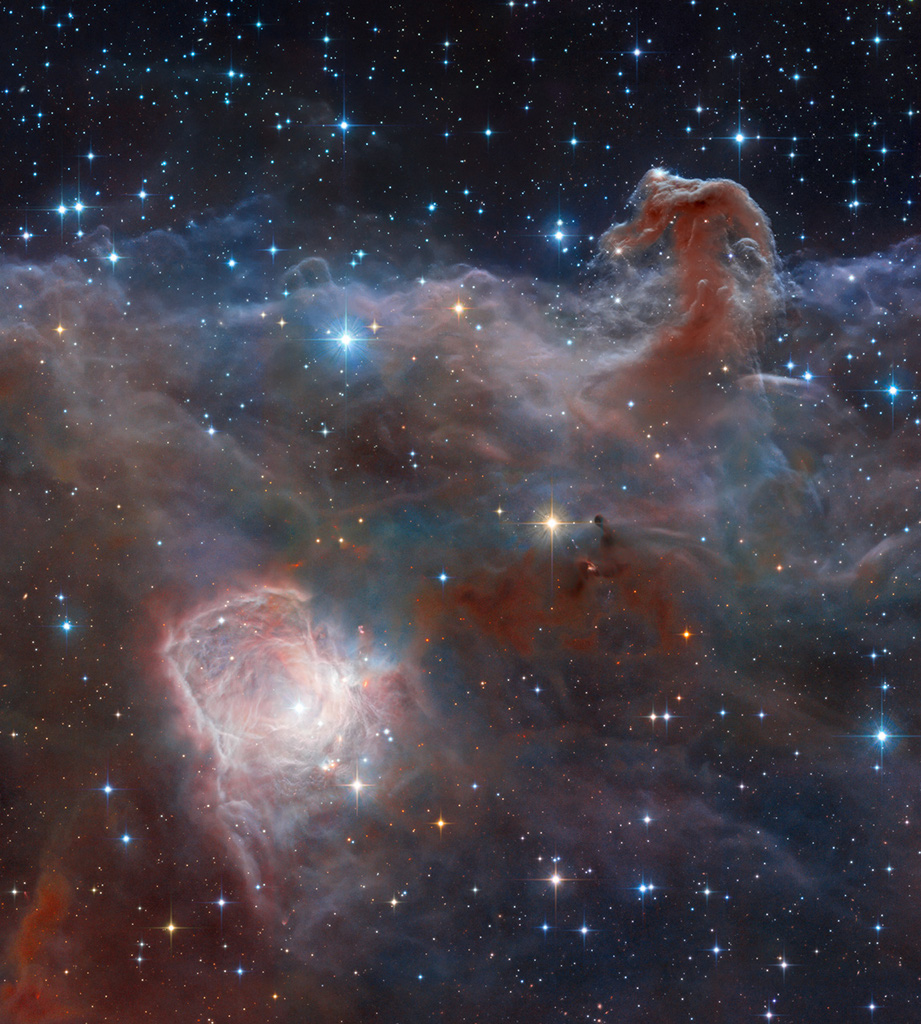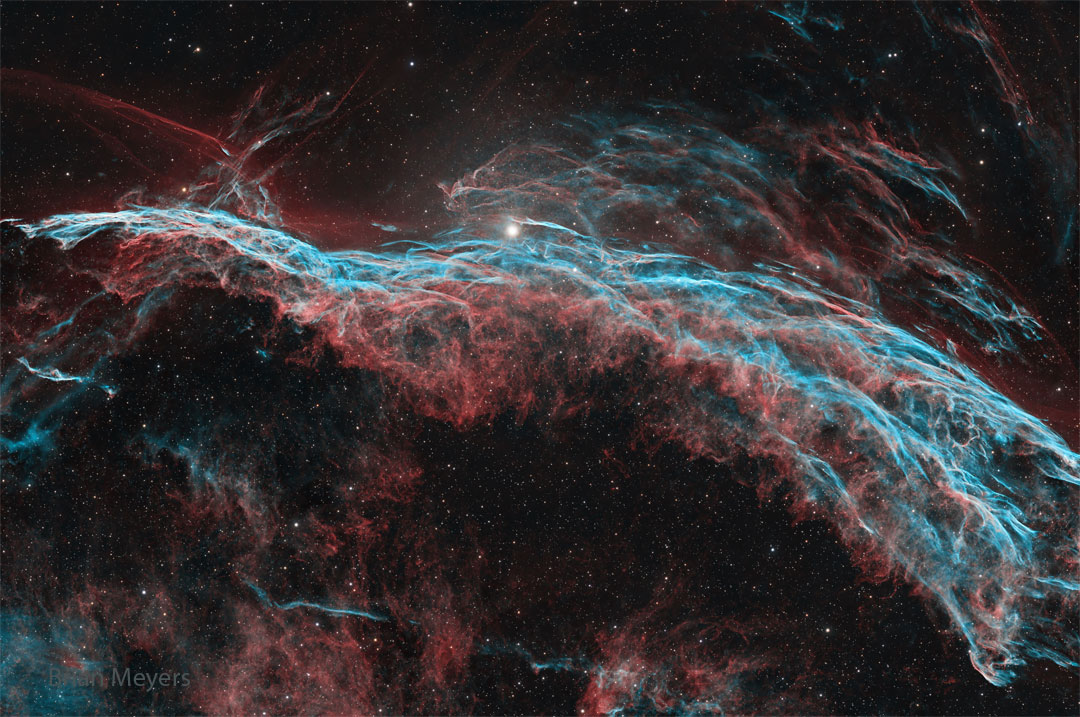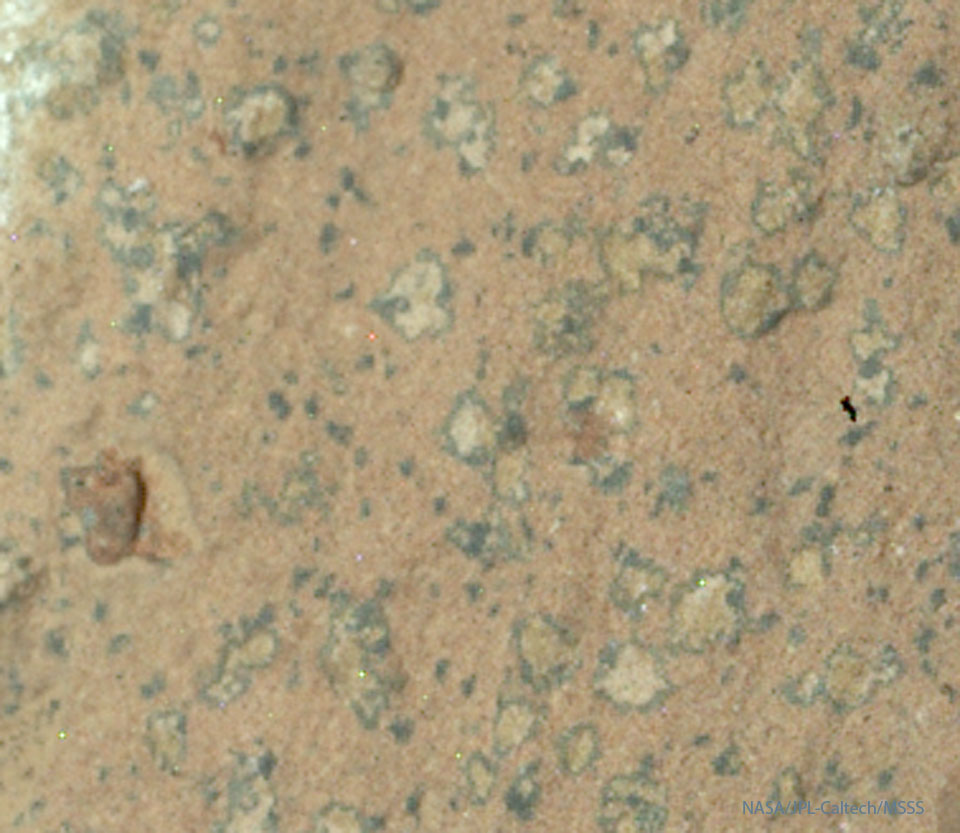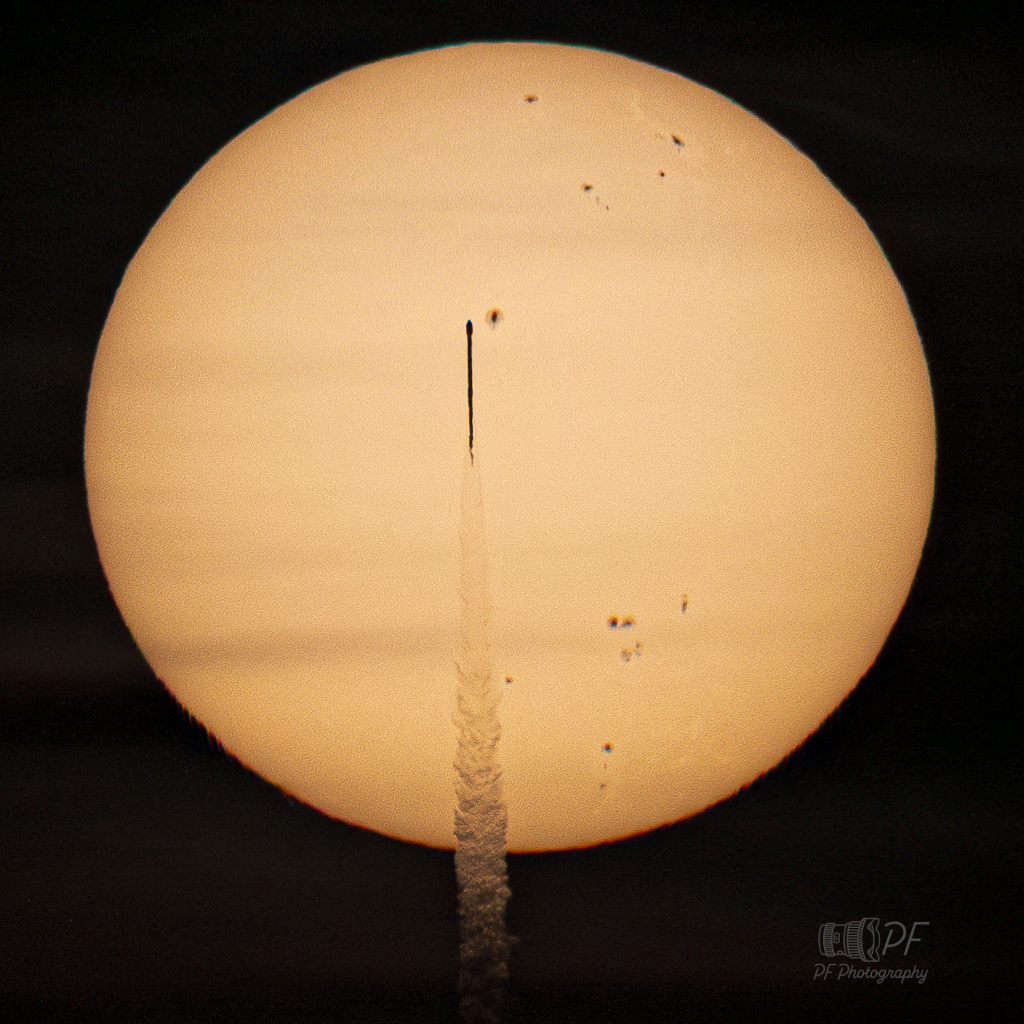
|
| Title: NASA pics | |
| Grapevine50sRoost > ~GENERAL~ > GENERAL DISCUSSION | Go to subcategory: |
| Author | Content |
|
zxxlyzq
|
|
|
Date Posted:09/03/2018 12:10 PMCopy HTML Composition and Processing: Robert Gendler Image Data: ESO, VISTA, HLA, Hubble Heritage Team (STScI/AURA) Explanation: Combined image data from the massive, ground-based VISTA telescope and the Hubble Space Telescope was used to create this wide perspective of the interstellar landscape surrounding the famous Horsehead Nebula. Captured at near-infrared wavelengths, the region's dusty molecular cloud sprawls across the scene that covers an angle about two-thirds the size of the Full Moon on the sky. Left to right the frame spans just over 10 light-years at the Horsehead's estimated distance of 1,600 light-years. Also known as Barnard 33, the still recognizable Horsehead Nebula stands at the upper right, the near-infrared glow of a dusty pillar topped with newborn stars. Below and left, the bright reflection nebula NGC 2023 is itself the illuminated environs of a hot young star. Obscuring clouds below the base of the Horsehead and on the outskirts of NGC 2023 show the tell-tale far red emission of energetic jets, known as Herbig-Haro objects, also associated with newborn stars. |
|
|
Megan57
|
Share to:





 #1
#1
|
|
Re:NASA pics Date Posted:03/10/2025 6:18 AMCopy HTML Sorry to see that |
|
|
Rockymz
|
Share to:





 #2
#2
|
|
Re:NASA pics Date Posted:02/10/2025 9:11 AMCopy HTML Astronomy Picture of the DayDiscover the cosmos! Each day a different image or photograph of our fascinating universe is featured, along with a brief explanation written by a professional astronomer. |
|
|
Rockymz
|
Share to:





 #3
#3
|
|
Re:NASA pics Date Posted:02/10/2025 8:32 AMCopy HTML Image Credit & Copyright: Koen van Barneveld Explanation: This surprising sky has almost everything. First, slanting down from the upper left and far in the distance is the central band of our Milky Way Galaxy. More modestly, slanting down from the upper right and high in Earth's atmosphere is a bright meteor. The dim band of light across the central diagonal is zodiacal light: sunlight reflected from dust in the inner Solar System. The green glow on the far right is aurora high in Earth's atmosphere. The bright zigzagging bright line near the bottom is just a light that was held by the scene-planning astrophotographer. This "almost everything" sky was captured over rocks on Castle Hill, New Zealand late last month. The featured finished frame is a combination of 10 exposures all taken with the same camera and from the same location. But what about the astrophotographer himself? He's pictured too -- can you find him? |
|
|
Megan57
|
Share to:





 #4
#4
|
|
Re:NASA pics Date Posted:02/10/2025 6:37 AMCopy HTML Amazing Rocky |
|
|
Rockymz
|
Share to:





 #5
#5
|
|
Re:NASA pics Date Posted:01/10/2025 8:07 AMCopy HTML Image Credit & Copyright: Brian Meyers Explanation: Ten thousand years ago, before the dawn of recorded human history, a new light would suddenly have appeared in the night sky and faded after a few weeks. Today we know this light was from a supernova, or exploding star, and record the expanding debris cloud as the Veil Nebula, a supernova remnant. This sharp telescopic view is centered on a western segment of the Veil Nebula cataloged as NGC 6960 but less formally known as the Witch's Broom Nebula. Blasted out in the cataclysmic explosion, an interstellar shock wave plows through space sweeping up and exciting interstellar material. Imaged with narrow band filters, the glowing filaments are like long ripples in a sheet seen almost edge on, remarkably well separated into atomic hydrogen (red) and oxygen (blue-green) gas. The complete supernova remnant lies about 1400 light-years away towards the constellation Cygnus. This Witch's Broom actually spans about 35 light-years. The bright star in the frame is 52 Cygni, visible with the unaided eye from a dark location but unrelated to the ancient supernova remnant. |
|
|
Megan57
|
Share to:





 #6
#6
|
|
Re:NASA pics Date Posted:01/10/2025 6:44 AMCopy HTML
|
|
|
Rockymz
|
Share to:





 #7
#7
|
|
Re:NASA pics Date Posted:30/09/2025 8:14 AMCopy HTML Image Credit & Copyright: Victor Sabet & Julien De Winter Explanation: Comet Lemmon is brightening and moving into morning northern skies. Besides Comet SWAN25B and Comet ATLAS, Comet C/2025 A6 (Lemmon) is now the third comet currently visible with binoculars and on long camera exposures. Comet Lemmon was discovered early this year and is still headed into the inner Solar System. The comet will round the Sun on November 8, but first it will pass its nearest to the Earth -- at about half the Earth-Sun distance -- on October 21. Although the brightnesses of comets are notoriously hard to predict, optimistic estimates have Comet Lemmon then becoming visible to the unaided eye. The comet should be best seen in predawn skies until mid-October, when it also becomes visible in evening skies. The featured image showing the comet's split and rapidly changing ion tail was taken in Texas, USA late last week. |
|
|
Megan57
|
Share to:





 #8
#8
|
|
Re:NASA pics Date Posted:30/09/2025 6:30 AMCopy HTML
|
|
|
Rockymz
|
Share to:





 #9
#9
|
|
Re:NASA pics Date Posted:29/09/2025 8:17 AMCopy HTML Image Credit & Copyright: Luc Perrot (TWAN) Explanation: It may look like these comets are racing, but they are not. Comets C/2025 K1 ATLAS (left) and C/2025 R2 SWAN (right) appeared near each other by chance last week in the featured image taken from France's Reunion Island in the southern Indian Ocean. Fainter Comet ATLAS is approaching our Sun and will reach its closest approach in early October when it is also expected to be its brightest -- although still only likely visible with long exposures on a camera. The brighter comet, nicknamed SWAN25B, is now headed away from our Sun, although its closest approach to Earth is expected in mid-October, when optimistic estimates have it becoming bright enough to see with the unaided eye. Each comet has a greenish coma of expelled gas and an ion tail pointing away from the Sun. |
|
|
Megan57
|
Share to:





 #10
#10
|
|
Re:NASA pics Date Posted:29/09/2025 6:35 AMCopy HTML
|
|
|
Rockymz
|
Share to:





 #11
#11
|
|
Re:NASA pics Date Posted:28/09/2025 9:14 AMCopy HTML Image Credit: NASA, JPL-Caltech, MSSS, Perseverance Rover Explanation: What is creating these unusual spots? Light-colored spots on Martian rocks, each surrounded by a dark border, were discovered last year by NASA's Perseverance Rover currently exploring Mars. Dubbed leopard spots because of their seemingly similarity to markings on famous Earth-bound predators, these curious patterns are being studied with the possibility they were created by ancient Martian life. The pictured spots measure only millimeters across and were discovered on a larger rock named Cheyava Falls. The exciting but unproven speculation is that long ago, microbes generated energy with chemical reactions that turned rock from red to white while leaving a dark biosignature ring, like some similarly appearing spots on Earth rocks. Although other non-biological explanations have not been ruled out, speculation focusing on this potential biological origin is causing much intrigue. |
|
|
Megan57
|
Share to:





 #12
#12
|
|
Re:NASA pics Date Posted:28/09/2025 7:37 AMCopy HTML
|
|
|
Rockymz
|
Share to:





 #13
#13
|
|
Re:NASA pics Date Posted:27/09/2025 9:23 AMCopy HTML Image Credit & Copyright: Pascal Fouquet Explanation: On the morning of September 24 a rocket crosses the bright solar disk in this long range telescopic snapshot captured from Orlando, Florida. That's about 50 miles north of its Kennedy Space Center launch site. This rocket carried three new space weather missions to space. Signals have now been successfully acquired from all three - NASA's Interstellar Mapping and Acceleration Probe, NASA’s Carruthers Geocorona Observatory, and the National Oceanic and Atmospheric Administration (NOAA) Space Weather Follow-On Lagrange 1 (SWFO-L1) - as they begin their journey to L1, an Earth-Sun lagrange point. L1 is about 1.5 million kilometers in the sunward direction from planet Earth. Appropriately, major space weather influencers, aka dark sunspots in active regions across the Sun, are posing with the transiting rocket. In fact, large active region AR4225 is just right of the rocket's nose. |
|
|
Megan57
|
Share to:





 #14
#14
|
|
Re:NASA pics Date Posted:27/09/2025 7:03 AMCopy HTML
|
|
|
Rockymz
|
Share to:





 #15
#15
|
|
Re:NASA pics Date Posted:26/09/2025 9:49 AMCopy HTML Image Credit & Copyright: Adam Block Explanation: A new visitor to the inner Solar System, comet C/2025 R2 (SWAN) sports a long ion tail extending diagonally across this almost 7 degree wide telescopic field of view recorded on September 21. A fainter fellow comet also making its inner Solar System debut, C/2025 K1 (ATLAS), can be spotted above and left of SWAN's greenish coma, just visible against the background sea of stars in the constellation Virgo. Both new comets were only discovered in 2025 and are joined in this celestial frame by ruddy planet Mars (bottom), a more familiar wanderer in planet Earth's night skies. The comets may appear to be in a race, nearly neck and neck in their voyage through the inner Solar System and around the Sun. But this comet SWAN has already reached its perihelion or closest approach to the Sun on September 12 and is now outbound along its orbit. This comet ATLAS is still inbound though, and will make its perihelion passage on October 8. |
|
|
Megan57
|
Share to:





 #16
#16
|
|
Re:NASA pics Date Posted:26/09/2025 6:37 AMCopy HTML
|
|
|
Rockymz
|
Share to:





 #17
#17
|
|
Re:NASA pics Date Posted:25/09/2025 8:18 AMCopy HTML Image Credit & Copyright: Jin Wang Explanation: This year Saturn was at opposition on September 21, opposite the Sun in planet Earth's sky. At its closest to Earth, Saturn was also at its brightest of the year, rising as the Sun set and shining above the horizon all night long among the fainter stars of the constellation Pisces. In this snapshot from the Qinghai Lenghu Observatory, Tibetan Plateau, southwestern China, the outer planet is immersed in a faint, diffuse oval of light known as the gegenschein or counter glow. The diffuse gegenschein is produced by sunlight backscattered by interplanetary dust along the Solar System's ecliptic plane, opposite the Sun in planet Earth's sky. Like a giant eye, on this dark night Saturn and gegenschein seem to stare down on the observatory's telescope domes seen against a colorful background of airglow along the horizon. |
|
|
Megan57
|
Share to:





 #18
#18
|
|
Re:NASA pics Date Posted:24/09/2025 6:55 AMCopy HTML
|
|
|
Rockymz
|
Share to:





 #19
#19
|
|
Re:NASA pics Date Posted:23/09/2025 10:24 AMCopy HTML Image Credit: NASA, ESA, CSA, STScI, JWST; Processing: Alyssa Pagan (STScI); Rollover: NASA, ESA, HST, & J. M. Apellániz (IAA, Spain); Acknowledgement: D. De Martin (ESA/Hubble) Explanation: How massive can a normal star be? Estimates made from distance, brightness and standard solar models had given one star in the open cluster Pismis 24 over 200 times the mass of our Sun, making it one of the most massive stars known. This star is the brightest object located in the central cavity near the bottom center of the featured image taken with the Webb Space Telescope in infrared light. For comparison, a rollover image from the Hubble Space Telescope is also featured in visible light. Close inspection of the images, however, has shown that Pismis 24-1 derives its brilliant luminosity not from a single star but from three at least. Component stars would still remain near 100 solar masses, making them among the more massive stars currently on record. Toward the bottom of the image, stars are still forming in the associated emission nebula NGC 6357. Appearing perhaps like a Gothic cathedral, energetic stars near the center appear to be breaking out and illuminating a spectacular cocoon. |
|
|
Megan57
|
Share to:





 #20
#20
|
|
Re:NASA pics Date Posted:23/09/2025 6:38 AMCopy HTML
|
|
|
Rockymz
|
Share to:





 #21
#21
|
|
Re:NASA pics Date Posted:22/09/2025 7:09 AMCopy HTML Image Credit & Copyright: Imran Sultan Explanation: On Saturn, the rings tell you the season. On Earth, today marks an equinox, the time when the Earth's equator tilts directly toward the Sun. Since Saturn's grand rings orbit along the planet's equator, these rings appear most prominent -- from the direction of the Sun -- when the spin axis of Saturn points toward the Sun. Conversely, when Saturn's spin axis points to the side, an equinox occurs, and the edge-on rings are hard to see from not only the Sun -- but Earth. In the featured montage, images of Saturn between the years of 2020 and 2025 have been superposed to show the giant planet passing, with this year's equinox, from summer in the north to summer in the south. Yesterday, Saturn was coincidently about as close as it gets to planet Earth, and so this month the ringed giant's orb is relatively bright and visible throughout the night. |
|
|
Megan57
|
Share to:





 #22
#22
|
|
Re:NASA pics Date Posted:22/09/2025 6:29 AMCopy HTML
|
|
|
Rockymz
|
Share to:





 #23
#23
|
|
Re:NASA pics Date Posted:21/09/2025 10:30 AMCopy HTML Image Credit: Luca Vanzella Explanation: Does the Sun set in the same direction every day? No, the direction of sunset depends on the time of the year. Although the Sun always sets approximately toward the west, on an equinox like today the Sun sets directly toward the west. After tomorrow's September equinox, the Sun will set increasingly toward the southwest, reaching its maximum displacement at the December solstice. Before today's September equinox, the Sun had set toward the northwest, reaching its maximum displacement at the June solstice. The featured time-lapse image shows seven bands of the Sun setting one day each month from 2019 December through 2020 June. These image sequences were taken from Alberta, Canada -- well north of the Earth's equator -- and feature the city of Edmonton in the foreground. The middle band shows the Sun setting during the last equinox -- in March. From this location, the Sun will set along this same equinox band again tomorrow. |
|
|
Megan57
|
Share to:





 #24
#24
|
|
Re:NASA pics Date Posted:20/09/2025 6:32 AMCopy HTML
|
|
|
Rockymz
|
Share to:





 #25
#25
|
|
Re:NASA pics Date Posted:20/09/2025 5:11 AMCopy HTML Image Credit & Copyright: Luca Bartek Explanation: Early risers around planet Earth have enjoyed a shining crescent Moon near brilliant Venus, close to the eastern horizon in recent morning twilight skies. And yesterday, on September 19, skygazers watching from some locations in Earth's northern hemisphere were also able to witness Venus, in the inner planet's waxing gibbous phase, pass behind the Moon's waning crescent. In fact, this telescopic snapshot was taken moments before that occultation of gibbous Venus by the crescent Moon began. The close-up view of the beautiful celestial alignment records Venus approaching part of the Moon's sunlit edge in clear daytime skies from the Swiss Alps. Tomorrow, the Sun will pass behind a New Moon. But to witness that partial solar eclipse on September 21, skygazers will need to watch from locations in planet Earth's southern hemisphere |
|
|
Rockymz
|
Share to:





 #26
#26
|
|
Re:NASA pics Date Posted:19/09/2025 9:38 AMCopy HTML Image Credit & Copyright: Tommy Lease Explanation: A study in contrasts, this colorful cosmic skyscape features stars, dust, and glowing gas in the vicinity of NGC 6914. The interstellar complex of nebulae lies some 6,000 light-years away, toward the high-flying northern constellation Cygnus and the plane of our Milky Way Galaxy. Obscuring interstellar dust clouds appear in silhouette while reddish hydrogen emission nebulae, along with the dusty blue reflection nebulae, fill the cosmic canvas. Ultraviolet radiation from the massive, hot, young stars of the extensive Cygnus OB2 association ionize the region's atomic hydrogen gas, producing the characteristic red glow as protons and electrons recombine. Embedded Cygnus OB2 stars also provide the blue starlight strongly reflected by the dust clouds. The over one degree wide telescopic field of view spans about 100 light-years at the estimated distance of NGC 6914. |
|
|
Megan57
|
Share to:





 #27
#27
|
|
Re:NASA pics Date Posted:18/09/2025 7:08 AMCopy HTML
|
|
|
Rockymz
|
Share to:





 #28
#28
|
|
Re:NASA pics Date Posted:17/09/2025 8:39 AMCopy HTML Image Credit & Copyright: J. De Winter, C. Humbert, C. Robert & V. Sabet; Text: Ogetay Kayali (MTU) Explanation: Can you spot famous celestial objects in this image? 18th-century astronomer Charles Messier cataloged only two of them: the bright Lagoon Nebula (M8) at the bottom, and the colorful Trifid Nebula (M20) at the upper right. The one on the left that resembles a cat's paw is NGC 6559, and it is much fainter than the other two. Even harder to spot are the thin blue filaments on the left, from supernova remnant (SNR G007.5-01.7). Their glow comes from small amounts of glowing oxygen atoms that are so faint that it took over 17 hours of exposure with just one blue color to bring up. Framing this scene of stellar birth and death are two star clusters: the open cluster M21 just above Trifid, and the globular cluster NGC 6544 at lower left. |
|
|
Megan57
|
Share to:





 #29
#29
|
|
Re:NASA pics Date Posted:17/09/2025 6:51 AMCopy HTML
|
|
|
Rockymz
|
Share to:





 #30
#30
|
|
Re:NASA pics Date Posted:16/09/2025 8:15 AMCopy HTML Image Credit & Copyright: Daniel Korona Explanation: A newly discovered comet is already visible with binoculars. The comet, C/2025 R2 (SWAN) and nicknamed SWAN25B, is brightening significantly as it emerges from the Sun's direction and might soon become visible on your smartphone -- if not your eyes. Although the brightnesses of comets are notoriously hard to predict, many comets appear brighter as they approach the Earth, with SWAN25B reaching only a quarter of the Earth-Sun distance near October 19. Nighttime skygazers will also be watching for a SWAN25B-spawned meteor shower around October 5 when our Earth passes through the plane of the comet's orbit. The unexpectedly bright comet was discovered by an amateur astronomer in images of the SWAN instrument on NASA's SOHO satellite. The comet is currently best observed in southern skies but is slowly moving north. The featured image was captured at sunset three days ago just above the western |




































